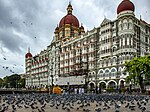Cathedral of the Holy Name, Mumbai
Churches in MumbaiGothic Revival church buildings in IndiaIndian church stubsRoman Catholic cathedral stubsRoman Catholic cathedrals in India ... and 3 more
Roman Catholic churches in MaharashtraRoman Catholic churches in MumbaiUse Indian English from July 2018

The Cathedral of the Holy Name or Holy Name Cathedral is a Roman Catholic cathedral in the Indian city of Mumbai (Bombay), that has the seat and is the headquarters of the Archbishop of Bombay. The cathedral is located in the Colaba area of South Bombay, built in the Gothic Revival style that was favoured by British architects. The cathedral is contained with the premises of the Holy Name High School founded in 1939.
Excerpt from the Wikipedia article Cathedral of the Holy Name, Mumbai (License: CC BY-SA 3.0, Authors, Images).Cathedral of the Holy Name, Mumbai
Convent Street, Mumbai Zone 1 (Mumbai)
Geographical coordinates (GPS) Address Nearby Places Show on map
Geographical coordinates (GPS)
| Latitude | Longitude |
|---|---|
| N 18.9233592 ° | E 72.8306699 ° |
Address
Holy Name High School
Convent Street
400001 Mumbai, Zone 1 (Mumbai)
Maharashtra, India
Open on Google Maps










